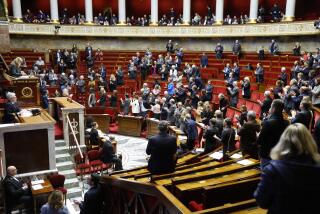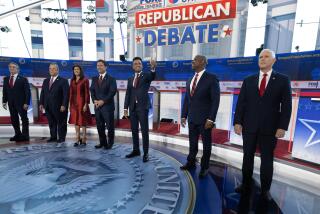Bush Compassion Reined by Fiscal Conservative Side
WASHINGTON â Sometimes his themes reprise Ronald Reagan. Other times they echo Bill Clinton.
Depending on the issue and the audience, President Bush can be equally comfortable denouncing the dangers of big government or extolling Washingtonâs potential to spur creative local solutions to entrenched social problems.
Through his first 100 days, Bush has sketched an agenda that takes the Republican Party in some new directions--especially on issues relating to the needy--but mostly reaffirms the prevailing currents of conservative thought that have dominated the GOP since his fatherâs defeat in 1992.
Indeed, on the left and the right, perhaps the principal surprise of Bushâs first months in office is how much core conservatism is embedded within his vision of âcompassionate conservatism.â Martin Anderson, former President Reaganâs top domestic policy advisor, says: âReagan would have been comfortable with what Bush is doing, especially on the major issues. If you look at the entire range of conservative positions, thatâs where Bush is.â
The picture actually is more complex. Compared to Reagan, who built his political appeal around the stark contention that âgovernment is the problem,â Bush accepts a larger responsibility for Washington in confronting problems such as persistent poverty and faltering public schools.
And the role Bush defines for Washington in those arenas overlaps Clintonâs vision of government as catalyst, in which the federal role is providing local institutions and individuals the means to solve problems themselves.
To Karl Rove, Bushâs political strategist, that focus on supporting local problem-solving is âthe essenceâ of the presidentâs compassionate conservatism. That theme runs through everything from Bushâs endorsement of block grants in education to his push to increase government partnerships with grass-roots, religion-based charities.
Yet Bush has proposed only modest new funding to support those local efforts. On education, which he has labeled his top domestic priority, he has proposed spending increases much smaller than those Clinton signed into law. And even these are the favored exceptions in Bushâs proposed budget, which would squeeze the growth of domestic spending for a decade while imposing the largest tax cut since Reaganâs in 1981.
In a rising chorus, Democrats are maintaining that these conventionally conservative fiscal priorities--and Bushâs equally resolute skepticism of federal environmental and workplace safety regulation--are undermining his promise of compassion.
âHe promised to bring a reform brand of conservatism to Washington and instead what heâs done is brought back the supply-side ideology--cutting governmentâs allowance and giving the powerful tax relief and redress from what they regard as burdensome regulation,â says Will Marshall, executive director of the Progressive Policy Institute, a centrist Democratic think tank.
A Chasm Remains
Marshallâs disillusion embodies an important larger trend shaping Bushâs presidency. During the campaign, Bush identified the Progressive Policy Institute as a source of ideas that could provide the basis for compromise across party lines. His first 100 days underscore how much space still separates even centrist Democrats from Bushâs vision of governmentâs proper role.
Like Clinton before him, Bush entered office hoping to find new compromises--a âthird wayâ--out of the long-standing arguments between the parties. Instead, the response to his agenda--particularly the nearly party-line votes in the House and Senate on his tax and spending plan--has shown how enduring and intransigent those disagreements remain.
The political question is which side of Bushâs agenda--the new compassion or the conventional conservatism--ultimately will define his presidency in the eyes of swing voters.
Bush has solidified his nearly unanimous support from rank-and-file Republicans, with conservatives raving about his commitment to tax cuts and his rolling back of Clinton administration regulations.
And Bush is enjoying a strong overall job approval rating at the 100-day mark, with about 60% of Americans in a flurry of new polls approving of his performance. So far, surveys suggest that most Americans see Bush as relatively centrist, personally honest and trustworthy, with a clear vision for the countryâs future. âPeople have confidence in this person,â Rove says.
But red flags also ripple through the early polls. The latest surveys suggest that Bush has made more progress personally ingratiating himself with the public than in selling his agenda.
When the tax and regulatory fights dominated the news earlier this spring, his disapproval rating among independents spiked upward only to retreat after the release of the U.S. spy plane crew detained in China. And polls now routinely find that most Americans believe Bush is more concerned about big business and the wealthy than about average citizens.
âWe have seen the White House consolidate their base in the initial days,â says John Weaver, the chief political advisor to Sen. John McCain (R-Ariz). âBut if that trend continues, Bush is taking the party toward a more narrow path.â
Like Clinton, Bush seems to be influenced as much by his partyâs failures as by its successes in shaping his governing agenda. For all his insistence on cutting taxes and restraining spending, Bush is less hostile to government than the ârevolutionaryâ generation of congressional GOP conservatives led by former House Speaker Newt Gingrich.
The characteristic difference is education. Gingrich wanted to eliminate the Education Department; Bush wants to increase federal education spending. And heâs pressing the limits of conservative tolerance for federal activism with an education plan that would require states to test students annually in reading and math.
âBush clearly is more inclined to accept more expansionary government activity in certain areas like education than other conservatives,â says Stuart Butler, vice president for domestic and economic studies at the conservative Heritage Foundation.
At the same time, Bush is considerably more conservative than his father, former President Bush, whose administration often seemed neither so much centrist nor conservative as adrift. Compared to his father, this Bush is more willing to cut and expand government.
Many of George W. Bushâs senior strategists believe that the way to control the center of debate is not to split the difference between the parties but to move strongly in both directions at once--offering ambitious government interventions where he considers appropriate and aggressively moving power away from Washington on other fronts. In that latter goal, heâs not lacking for ambition. Besides his massive tax cut plan, Bush already has signaled that later this year he will offer the most fundamental changes in Social Security and Medicare since their inception--proposing to restructure each program around the theme of shifting control and risk from government to individuals.
âThe fact of the matter is that we are not mushy moderates,â one senior White House aide insists. âWe are conservative on taxes and we have a compassionate conservative approach on social policy. Those things are not in tension. People can focus on one or the other, but they are going to both be there.â
In this balancing act, Bush has offered new government programs on only a limited set of issues. Education has been the most prominent, but his budget also contains a series of proposals clustered around the problems of urban communities and working-poor families. These efforts range from helping needy families buy homes and obtain health insurance to aiding unwed teenage mothers, the fathers of their children and the children of inmates.
In almost all cases, Bush proposes something less than new federal spending programs. Tax credits are at the heart of his plans to increase home ownership and spread health insurance. He would pursue many of his goals through grants to grass-roots groups--including religion-based charities--already working on the problems. The emblematic program in Bushâs budget might be his âcompassion capital fund,â designed to nurture innovative programs from local faith-based charities.
The common thread is to use government as a catalyst that activates market forces or local organizations. Taken together, Rove argues, this approach amounts to Bushâs own third way: a path between âlibertarian indifference and bureaucratic centralization.â
A âFiscal Stringencyâ
Those broad concepts appeal to many reform-oriented Democrats who share Bushâs skepticism about the efficiency of traditional Washington-based programs; many of Clintonâs programs placed a similar priority on nurturing local initiative.
Yet Democrats of all stripes complain that, because his tax cut proposal consumes so much of the projected budget surplus, Bush is not offering enough federal money to truly help those efforts grow. His compassion fund, for instance, would dispense only $89 million next year; many independent analysts say his health care tax credit is too small to provide coverage for most uninsured families. Likewise, Democrats insist Bush is not offering nearly enough new aid to help schools meet the higher standards he hopes to promote.
âThe tax hole is so big that heâs had to impose a severe fiscal stringency through the rest of the budget,â the Progressive Policy Instituteâs Marshall says. âThat means there is no money for the kind of reforms that he indicated he was interested in.â
To which Rove fires back: âThatâs the old paradigm. The old thinking equates the provision of money with the achievement of success.â
This is a familiar argument between Democrats and Republicans, which may be its real point. Here and there, Bush is changing the point of collision between the parties. But mostly his first 100 days have illuminated the lasting distance between the paths the two sides would steer toward progress.
More to Read
Get the L.A. Times Politics newsletter
Deeply reported insights into legislation, politics and policy from Sacramento, Washington and beyond. In your inbox three times per week.
You may occasionally receive promotional content from the Los Angeles Times.










